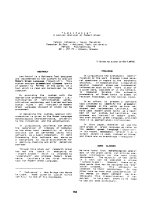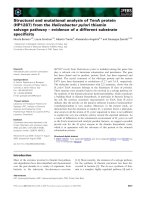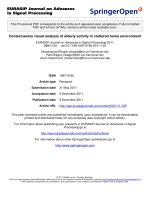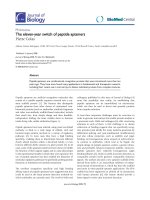Báo cáo sinh học : "Q&A: Genetic analysis of quantitative traits" pdf
Bạn đang xem bản rút gọn của tài liệu. Xem và tải ngay bản đầy đủ của tài liệu tại đây (126.42 KB, 5 trang )
Question & Answer
QQ&&AA:: GGeenneettiicc aannaallyyssiiss ooff qquuaannttiittaattiivvee ttrraaiittss
Trudy FC Mackay
WWhhaatt aarree qquuaannttiittaattiivvee ttrraaiittss??
Quantitative, or complex, traits are
traits for which phenotypic variation
is continuously distributed in natural
populations, with population
variation often approximating a
statistical normal distribution on an
appropriate scale. Quantitative traits
include aspects of morphology
(height, weight); physiology (blood
pressure); behavior (aggression); as
well as molecular phenotypes (gene
expression levels, high- and low-
density cholesterol levels).
WWhhaatt ccaauusseess tthhee ccoonnttiinnuuoouuss
ddiissttrriibbuuttiioonn ooff pphheennoottyyppeess ffoorr
qquuaannttiittaattiivvee ttrraaiittss??
The continuous variation for complex
traits is due to genetic complexity and
environmental sensitivity. Genetic
complexity arises from segregating
alleles at multiple loci. The effect of
each of these alleles on the trait
phenotype is often relatively small,
and their expression is sensitive to the
environment. Allelic effects can also
depend on genetic background and
sex. Because of this complexity, many
genotypes can give rise to the same
phenotype, and the same genotype
can have different phenotypic effects
in different environments. Thus, there
is no clear relationship between
genotype and phenotype.
DDooeess tthhiiss mmeeaann yyoouu ccaann''tt sseeee
MMeennddeelliiaann rraattiiooss ffoorr qquuaannttiittaattiivvee
ttrraaiittss??
Yes, because of the small magnitude
of the allelic effects on the phenotype.
Mendelian variants have large effects
on the phenotype so there is a clear
correspondence between genotype at a
locus and trait phenotype. For any
trait there is a continuum of allelic
effects from small to large: the large
effects segregate as Mendelian
variants, while the small effects
segregate as quantitative genetic
variation. For example, human height
is a classic quantitative trait, but
achondroplasia (dwarfism) is caused
by a Mendelian autosomal dominant
mutation in the fibroblast growth factor
receptor 3 gene.
WWhhyy aarree qquuaannttiittaattiivvee ttrraaiittss
iimmppoorrttaanntt??
Quantitative genetic variation is the
substrate for phenotypic evolution in
natural populations and for selective
breeding of domestic crop and animal
species. Quantitative genetic variation
also underlies susceptibility to
common complex diseases and
behavioral disorders in humans, as
well as responses to pharmacological
therapies. Knowledge of the genetic
basis of variation for quantitative traits
is thus critical for addressing
unresolved evolutionary questions
about the maintenance of genetic
variation for quantitative traits within
populations and the mechanisms of
divergence of quantitative traits
between populations and species; for
increasing the rate of selective
improvement of agriculturally
important species; and for developing
novel and more personalized
therapeutic interventions to improve
human health.
HHooww ccaann yyoouu iiddeennttiiffyy ggeenneess
aaffffeeccttiinngg qquuaannttiittaattiivvee ttrraaiittss??
This is usually done in stages. In the
first stage, we map quantitative trait
loci (QTLs) affecting the trait. QTLs
are genomic regions in which one or
more alleles affecting the trait
segregate. In the second stage, we
focus in on each QTL region to further
narrow the genomic intervals
containing the gene or genes affecting
variation in the trait. The final and
third stage is most challenging:
pinpointing the causal genes.
HHooww ddoo yyoouu mmaapp QQTTLLss??
There are two basic approaches:
linkage mapping and association
mapping. Both approaches are based
on the principle that QTLs can be
tracked via their genetic linkage to
visible marker loci with genotypes that
we can readily classify. The most
common markers used today are
molecular markers, such as single
nucleotide polymorphisms (SNPs),
polymorphic insertions or deletions
(indels), or simple sequence repeats
(also known as microsatellites). If a
QTL is linked to a marker locus, then
on average individuals with different
marker locus genotypes will have a
different mean value of the
quantitative trait (Figure 1). Linkage
Journal of Biology
2009,
88::
23
Trudy F C Mackay, Department of Genetics,
North Carolina State University, Raleigh
NC 27695-7614, USA.
Email:
mapping involves tracing the linkage
of a trait with a marker either through
families in outbred populations (such
as human populations), or by
breeding experiments in which animal
or plant strains that vary for the trait
are crossed through several
generations. By contrast, association
mapping looks for associations
between a marker and different values
of a trait in unrelated individuals
sampled directly from a population.
In both cases, we need to obtain
measurements of the phenotype and
determine the marker locus genotypes
for all individuals in the mapping
population, at all marker loci. Then
we use a statistical method to
determine whether there are
differences in the value of the
quantitative trait between individuals
with different marker locus genotypes;
if so, the QTL is linked to the marker.
We repeat this for every marker (or
pair of adjacent markers) to perform a
genome scan for QTLs. The results of a
genome scan are depicted graphically,
as shown in Figure 2.
SSoo mmaappppiinngg QQTTLLss ddeeppeennddss
ccrruucciiaallllyy oonn ssttaattiissttiiccaall eexxppeerrttiissee??
It is important to understand the
principles of the experimental design to
measure the quantitative trait
phenotypes in the mapping
population, and consultation with a
statistician is recommended if you have
any questions about these principles.
The actual mapping methods do not
require strong statistical expertise.
There are many freely available
statistical programs for implementing
QTL mapping methods and using
permutation to determine appropriate
significance thresholds. Two popular
software suites are QTL Cartographer
( and R-
QTL ().
IIff ssttaattiissttiiccaall tteessttss aarree nneeeeddeedd ffoorr
mmaappppiinngg,, yyoouu mmuusstt nneeeedd aa lloott ooff
iinnddiivviidduuaallss ttoo mmaapp qquuaannttiittaattiivvee
t
trraaiittss??
This is a key question. The answer has
two components: the number of
individuals needed to detect a QTL
and the number required to localize
the gene or genes at the QTL. The
23.2
Journal of Biology
2009, Volume 8, Article 23 Mackay />Journal of Biology
2009,
88::
23
FFiigguurree 11
Illustration of hypothetical data on height for 15 individuals at each of two marker loci, one with alleles
A
and
T
, the other with alleles
C
and
G
.
((aa))
Individuals with the
AA
genotype are taller than those with the
TT
genotype. Therefore, a QTL affecting height is linked to this marker locus.
((bb))
There is no significant difference in height between individuals with the
CC
and
GG
genotypes. Therefore, no QTLs affecting height are linked to this
marker locus.
Height
AA
Genotype
(a)
TT
Height
CC
Genotype
GG
(b)
answer also depends on whether you
are doing a linkage study or an
association study. To detect a QTL in a
linkage study, you need to identify a
reliable difference in the average value
of the trait between marker genotypes.
How many individuals you need for
this depends broadly on the frequency
of the QTL alleles in the population
you are looking at, and how large their
effects are. (More precisely - the power
to detect a difference in the mean
value of the trait between two marker
genotypes depends on
δ
/
σ
w
, where
δ
is
the difference in mean between the
marker classes, and
σ
w
is the standard
deviation of the trait within each
marker genotype class.) In a linkage-
mapping study, the different alleles
are generally at intermediate
frequency, and in this case, the marker
genotype and quantitative trait
phenotype must be recorded for more
than 500-1,000 individuals if the QTL
has a moderate effect (
δ
/
σ
w
= 0.25).
For QTLs with small effects (
δ
/
σ
w
=
0.0625), much larger sample sizes
(more than 10,000 individuals) are
needed. Allele frequencies can be
more extreme with association
mapping designs, and this translates
to greater sample sizes required to
detect QTLs. For example, more than
30,000 individuals would be
necessary to detect a moderate effect
QTL (
δ
/
σ
w
= 0.25) for which the
frequency of the rare allele was 0.1.
SSoo wwhhaatt aabboouutt tthhee nnuummbbeerrss
rreeqquuiirreedd ttoo llooccaalliizzee aa QQTTLL??
To localize a QTL you need
individuals in which recombination
has occurred in the vicinity of the QTL
so that only markers very close to the
QTL on the chromosome remain
linked to it. The bottom line is that
the more precisely we want to localize
a QTL by linkage (in terms of the
recombination fraction, c), the larger
the number of individuals necessary.
For example, we would only need 29
individuals to detect at least one
recombinant in a 10 cM interval (c =
0.10), but 2,994 individuals to detect
at least one recombinant in a 0.1 cM
interval (c = 0.001).
WWoouullddnn''tt yyoouu aallssoo nneeeedd aa lloott ooff
mmaarrkkeerrss,, ttoo bbee ssuurree tthhaatt ssoommee
wweerree vveerryy cclloossee ttoo tthhee QQTTLL??
Yes. The smaller the physical distance
on the chromosome, the smaller the
number of recombinants will be, and
the larger the marker density we need
to identify them. The relationship
between recombination fraction and
physical distance varies between
species and across the genome within
species. We can infer the scale of
mapping using the Drosophila genome
as an example, where a QTL localized
to a 5 cM interval would span 2,100
kb and include on average 245 genes,
whereas a QTL localized to a 1 cM
interval would span 420 kb and
include 49 genes. Clearly, extremely
large linkage-mapping populations
would be needed if we attempted to
simultaneously detect QTLs and
localize them to small chromosomal
regions. That is why linkage mapping
of QTLs is typically an iterative
procedure where we first determine
the general location ( in 10-20 cM
intervals) of QTLs in a mapping
population of several hundred to
approximately a thousand individuals.
We then narrow down the regions that
we know contain the QTLs, and
determine their location more
precisely by focusing on individuals in
which recombination has occurred
between the markers flanking the QTL
- and then essentially repeat the whole
procedure on the smaller genomic
regions. This phase requires breeding
many more individuals to obtain the
necessary recombination, and
identifying molecular markers within
the region of interest. These
experiments are very laborious and
/>Journal of Biology
2009, Volume 8, Article 23 Mackay 23.3
Journal of Biology
2009,
88::
23
FFiigguurree 22
The results of a genome scan are depicted graphically, where the locations of the markers are
given on the
x
-axis (black triangles), and the result of the statistical test is indicated on the
y
-axis
(here a likelihood ratio test). The significance threshold is given by the horizontal line parallel to
the
x
-axis and intersecting the
y
-axis at the appropriate value. The significance threshold has been
adjusted to account for the number of independent tests performed, and was determined by a
permutation test. Evidence for linkage of a QTL with markers occurs when the test for linkage
generates a significance level that exceeds the permutation threshold. The best estimate of the
QTL location is the position on the
x
-axis corresponding to the greatest significance level.
Testing Position (cM)
Likelihood Ratio test
0
0 20 40 60 80 100 120
10
20
30
40
50
rarely result in positional cloning of
QTLs.
WWhhaatt iiss tthhee ddiiffffeerreennccee bbeettwweeeenn
lliinnkkaaggee aanndd aassssoocciiaattiioonn mmaappppiinngg
ffrroomm tthhee ppooiinntt ooff vviieeww ooff
nnuummbbeerrss ooff
iinnddiivviidduuaallss aanndd
mmaarrkkeerrss nneeeeddeedd??
Association mapping is done on
random-mating, and thus much more
heterogeneous, populations, so there
will be more recombinant individuals,
and thus fewer individuals are
necessary to localize QTLs. The
number of markers required in an
association mapping study depends
on the scale and pattern of linkage
disequilibrium (LD) - that is, the
correlation of allele frequencies at two
or more polymorphic loci, or the
tendency of a particular pair or group
of alleles to be found together in
different individuals. If a group of
markers is in high LD, we only need to
genotype one of them as a proxy for
all the others in the LD block. Thus, in
species with large LD blocks, such as
pure breeds of dogs, only a few
markers may be required for QTL
detection, but it will not be possible to
localize QTLs very precisely by within-
breed association mapping. In
contrast, knowledge of all sequence
variants is necessary for association
mapping in species like Drosophila,
where LD can decline very rapidly
over short physical distances. Under
this scenario, however, QTL
localization can be quite precise. In
humans, commercial genotyping
arrays with many hundreds of
thousands of markers spanning the
whole genome have been developed,
based on tagging SNPs in LD blocks,
facilitating a new era of genome-wide
association studies in people. The
requirement for genotyping large
numbers of markers in large numbers
of individuals has meant that, until
recently, most association-mapping
studies have been for a candidate gene
or candidate gene region, and used
only a subset of all possible molecular
polymorphisms.
WWhhiicchh iiss bbeetttteerr,, lliinnkkaaggee mmaappppiinngg
oorr aassssoocciiaattiioonn mmaappppiinngg??
Both methods have advantages and
disadvantages. Linkage mapping,
particularly in controlled crosses (as
opposed to, say, human families), has
the advantage of increased power to
detect QTLs because all segregating
alleles are at intermediate frequency,
whereas allele frequencies in a
population used for association
mapping can vary throughout the
entire range. On the other hand,
association mapping can give
increased power to localize QTLs
because of the higher recombination
between markers and QTL alleles
in random-mating populations.
Recombination can be increased in
linkage-mapping designs by random
mating of F
2
or backcross populations
for several generations (so-called
advanced intercross lines). Linkage
mapping also has the disadvantage of
reduced genetic diversity, especially
when crosses between a pair of lines
are used to create the mapping
population. Association mapping
samples the whole gamut of genetic
diversity in the population. The
reduced genetic diversity in linkage-
mapping populations can be
somewhat alleviated by starting from
crosses of four or eight initial parental
strains. Finally, association mapping
relies on LD between marker alleles
and QTL alleles, and any mixing of
different populations can cause LD
that is not due to close linkage, thus
leading to incorrect conclusions.
HHooww ddoo yyoouu iiddeennttiiffyy tthhee ggeenneess
ccoorrrreessppoonnddiinngg ttoo QQTTLLss??
QTL mapping will identify a genomic
region containing one or more
candidate genes affecting the trait.
Determining which one(s) are causal
is the next step. The most
straightforward method is high-
resolution recombination mapping.
However, this method is limited to
QTL alleles with large effects and to
organisms amenable to the
experimental generation of tens of
thousands of recombinants.
Otherwise, we need to seek
corroborating evidence, such as DNA
polymorphisms between alternative
alleles of one of the candidate genes
that could change the protein, a
difference in mRNA expression levels
between genotypes, or expression of
RNA or protein in tissues thought to
be relevant to the trait. Associations of
markers in candidate genes with the
trait that are replicated in independent
studies also constitute strong evidence
that the gene affects variation in the
trait. In model organisms, it is
possible to test whether a mutation in
one of the candidate genes affects the
trait, or whether the mutant gene fails
to complement QTL alleles. Formal
proof that a specific allelic
substitution affects the trait comes
from replacing the allele of a
candidate gene in one strain with that
of the other, without introducing any
other changes in the genetic
background, but this is not possible in
very many organisms.
WWhhaatt hhaavvee wwee lleeaarrnneedd ffrroomm QQTTLL
mmaappppiinngg??
While literally thousands of studies
have been published reporting QTLs
for all imaginable traits (including
biochemical traits, such as transcript
abundance) and in a wide range of
organisms, few actual genes
corresponding to QTLs have been
identified, and these represent alleles
with large effects and thus only a very
small proportion of QTLs. We now
know that most alleles affecting
quantitative traits have very small
effect, and it is clear that most
experimental efforts to map QTLs
have not been large enough to detect
them. Furthermore, QTLs that have
23.4
Journal of Biology
2009, Volume 8, Article 23 Mackay />Journal of Biology
2009,
88::
23
been detected often break down into
multiple linked QTLs with smaller
effects when subjected to high-
resolution mapping. It is also clear
that mapping studies so far are likely
to have missed much of the genetic
variation responsible for quantitative
traits. This follows from the fact that
the number of QTLs detected is
usually positively correlated with the
sample size of the mapping
population, so if the smaller studies
were enlarged more QTL would
presumably emerge. Thus, it appears
that large numbers of loci are
responsible for quantitative genetic
variation. Some surprises have come
from QTL mapping: many genes
corresponding to QTLs are previously
unknown genes predicted
computationally from genome
sequences, genes affecting
development associated with adult
quantitative traits, or even genes
occurring in otherwise 'gene deserts'.
QTLs often have allelic effects that
vary depending on background
genotype, environment and sex. All
kinds of molecular polymorphisms
(SNPs, indels, microsatellites and
transposable genetic elements) have
been associated with variation for
quantitative traits. While some
variants have potentially functional
effects on the translated protein,
others are synonymous substitutions
in protein-coding regions, or variants
in non-coding regions with presumed
regulatory effects.
WWhhaatt hhooppee iiss tthheerree ffoorr ddiisssseeccttiinngg
tthhee ggeenneettiicc bbaassiiss ooff vvaarriiaattiioonn ooff
qquuaannttiittaattiivvee ttrraaiittss??
In the past 20 years, there has been a
shift from optimism to pessimism. At
first, it seemed possible that QTL
mapping could identify something
like several to tens of loci with alleles
of moderate to large effect that could
explain quantitative traits and
complex diseases. Latterly, it has
become clear that the task will be to
identify unambiguously hundreds of
genes with alleles with small effects
affecting any one trait, and success
seems more remote. The challenge
becomes particularly arduous given
context-dependent effects and the
prospect of drilling down from QTL
region to candidate gene one QTL at a
time.
Several recent technical developments
offer the hope of overcoming the
difficulties, however. Two major
obstacles have been the need for a
dense panel of molecular markers for
high-resolution mapping in the
organism of interest, and for a way of
genotyping these markers
economically and in parallel in tens of
thousands of individuals. Next-
generation sequencing methods make
possible the rapid identification of
large numbers of polymorphisms in
parental strains used in linkage-
mapping studies, or a sample of
individuals from a population
targeted for association mapping, and
several companies offer custom
genotyping designs for massively
parallel genotyping. As the cost of
sequencing plummets, we can
conceive of eventually determining
the whole-genome sequence of every
individual in a large population,
pushing the challenge of genetic
dissection of quantitative traits
towards accurate and high-throughput
phenotyping. In addition, molecular
polymorphisms do not directly affect
quantitative traits, but do so by
altering levels of transcript abundance,
amount and activity of proteins,
metabolites and other 'intermediate'
phenotypes. Incorporating measures
of variation in intermediate
phenotypes with genetic variation in
molecular markers and quantitative
phenotypic variation will provide a
biological context in which to
interpret the phenotype. Finally,
quantitative traits do not exist in a
vacuum, but are connected to other
traits via the pleiotropic effects of
functional variants. Projects to
develop sequenced genetic reference
panels for model organisms as
community resources for QTL
mapping (for example, the mouse
Collaborative Cross consortium, the
Drosophila Genetic Reference Panel,
and the Arabidopsis 1001 Genomes
Project) will make possible large-scale
measurement of multiple phenotypes,
including intermediate phenotypes, in
multiple environments. These
resources offer the prospect of
elucidating the genetics of the
interdependence of multiple
phenotypes, and addressing the
longstanding question of the genetic
basis of genotype-environment
interaction.
WWhheerree ccaann II ggoo ffoorr mmoorree
iinnffoorrmmaattiioonn??
Reviews
Mackay TFC:
TThhee ggeenneettiicc aarrcchhiitteeccttuurree ooff
qquuaannttiittaattiivvee ttrraaiittss
Annu Rev Genet
2001,
3355::
303–339.
Weiss KM:
TTiillttiinngg aatt qquuiixxoottiicc ttrraaiitt llooccii ((QQTTLL))::
aann eevvoolluuttiioonnaarryy ppeerrssppeeccttiivvee oonn ggeenneettiicc
ccaauussaattiioonn
Genetics
2008,
117799::
1741-
1756.
Textbooks
Falconer DS, Mackay TFC:
Introduction to
Quantitative Genetics
, 4
th
edition.
Harlow, Essex: Longman; 1996.
Lynch M, Walsh B:
Genetics and Analysis of
Quantitative Traits
. Sunderland, MA:
Sinauer; 1998.
Published: 17 April 2009
Journal of Biology
2009,
88::
23
(doi:10.1186/jbiol133)
The electronic version of this article is the
complete one and can be found online at
/>© 2009 BioMed Central Ltd
/>Journal of Biology
2009, Volume 8, Article 23 Mackay 23.5
Journal of Biology
2009,
88::
23









